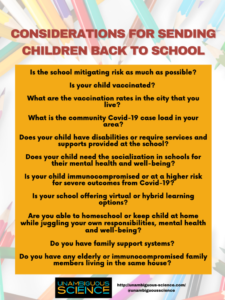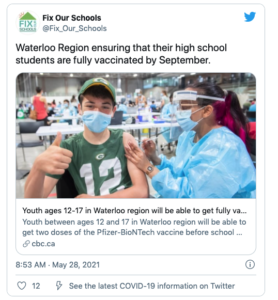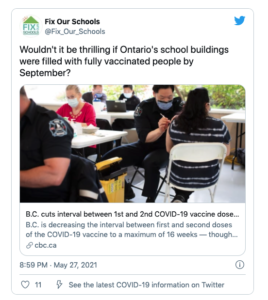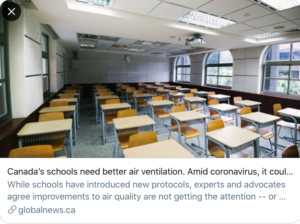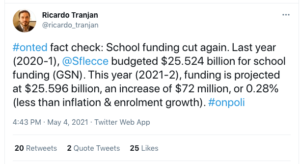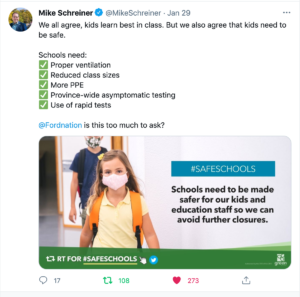More Proof that School Conditions Matter
Fix Our Schools began is a parent-led, non-partisan, Ontario-wide campaign focused on ensuring all publicly funded school buildings, portables and schoolyards are safe, healthy, well-maintained, and provide environments conducive to learning and working. Since we launched in 2014, we have always believed that school conditions matter. Taking care of the capital assets we call public schools makes good financial sense, and has also been shown to improve the health, learning, attendance and performance of the learners and workers who spend their days at school.
A September, 2021 study led by Harvard’s T.H. Chan School of Public Health found that, “the air quality within an office can have significant impacts on employees’ cognitive function, including response times and ability to focus, and it may also affect their productivity“. In fact, cognitive function test were 61%-101% higher in buildings with higher ventilation than in conventional buildings. Clearly, indoor air quality in schools could have a significant impact on students’ cognitive function, and their ability to learn. Not much of a stretch to extrapolate this conclusion!
A new study led by Harvard Chan School researchers has found that increased concentrations of fine particulate matter and lower ventilation rates in offices were associated with employees' slower response times and reduced accuracy on cognitive tests. https://t.co/KZzeZbdBOQ
— Harvard T.H. Chan School of Public Health (@HarvardChanSPH) September 9, 2021
The COVID-19 pandemic has clearly demonstrated the urgency of ensuring good ventilation and indoor air quality. Joseph Allen, Associate Professor of Exposure Assessment Science and senior author on the Harvard study mentioned above, noted that “the value proposition of these strategies extends to cognitive function and productivity of workers, making healthy buildings foundational to public health and business strategy moving forward.”
How Do We Ensure Excellent School Conditions in Ontario?
If we accept that school conditions matter, then we must take the following steps:
1. Develop and implement a Standard of Good Repair for Ontario’s publicly funded schools, including transparent metrics for school buildings, portables and schoolyards. These standards and associated metrics would include and address:
-
- The $16.8-billion of disrepair in school buildings
- A program to assess current repair backlogs in portables and schoolyards
- Air quality and ventilation
- Classroom temperatures
- Accessibility
- Environmental efficiency & durability
- Job site safety for school construction projects and maintenance work
- Drinking water
- Asbestos
- Cleanliness
- Classroom space
- Vermin, mold
- Fire and electrical code
2. Provide Ontario’s publicly funded schools with adequate, stable, equitable funding that ensures these standards are met; and publicly demonstrate positive outcomes by collecting and releasing associated metrics at regular intervals.
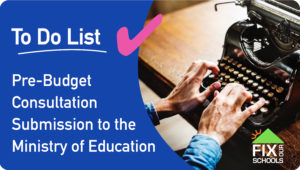 Fix Our Schools provided these recommendations to the Ministry of Education as part of its 2022-23 Education Funding consultation process, highlighting that, at a minimum, an additional $1.6-B/year is required (on top of the current $1.4-B/year provincial funding for school repair and renewal) to start to turn the tide on the ever-growing backlog of disrepair in Ontario’s schools. This level of increased funding is a recommendation that we have been making to since 2017 and, with each year that successive governments have failed to heed this call to action, the repair backlog in Ontario’s schools has grown.
Fix Our Schools provided these recommendations to the Ministry of Education as part of its 2022-23 Education Funding consultation process, highlighting that, at a minimum, an additional $1.6-B/year is required (on top of the current $1.4-B/year provincial funding for school repair and renewal) to start to turn the tide on the ever-growing backlog of disrepair in Ontario’s schools. This level of increased funding is a recommendation that we have been making to since 2017 and, with each year that successive governments have failed to heed this call to action, the repair backlog in Ontario’s schools has grown.
In fact, the repair backlog in Ontario’s schools has grown from $15.9-B in November, 2017 (the last time that full disrepair data was released by the provincial government) to $16.8-B. And, as we’ve noted previously, this $16.8-B number does not even begin to include many important aspects of school infrastructure.
Fix Our Schools has always been open to exploring all ideas for funding solutions that could result in safe, healthy, well-maintained schools. We would welcome further exploration of the following ideas as well:
- Separating the assets we happen to call “public schools ” today (but that could become community hubs serving seniors in two decades time) from the education that is delivered in these buildings could be a powerful shift that could unlock new revenue streams. Education is engrained in the Canadian constitution as a provincial responsibility so when we include school infrastructure as part of “education”, our provincial governments in Canada are then solely responsible for funding both public education and public school infrastructure (school buildings, portables and schoolyards). However, if we delineate school infrastructure from education, then municipal, provincial, and federal governments could (and should!) contribute to funding safe, healthy, well-maintained school infrastructure.
- Similarly, if the capital assets we call schools were considered to be separate and distinct from the education delivered in schools, perhaps school infrastructure would be better managed by an entity with power over the funding and policies, and accountability over the outcomes. As economist Hugh Mackenzie has noted, “The (Provincial) government is fully responsible for the level of funding provided but local school boards bear the consequences and are accountable for the results. Despite the government’s complete control over funding, there is no provincial accountability mechanism for the performance of and funding for the system as a whole.” As Fix Our Schools has noted time and again, Ontario’s school boards are at the mercy of the provincial funding model, and the provincial government of the day blames school boards for substandard school conditions, even though the provincial funding to maintain, repair and build schools has been chronically and grossly inadequate. This is the dynamic that has led to a large and growing repair backlog in Ontario’s public schools that now sits at a gob-smacking $16.8-billion, and therefore is a dynamic that must be examined and changed. School infrastructure could, perhaps, become the responsibility of the provincial government rather than the responsibility of school boards. Or, school boards could, perhaps, be given back the power of taxation. Or, perhaps if Municipalities and the Federal government were also involved in the funding of maintenance, repair and building of school infrastructure, there are other models to be considered.
- The Toronto District School Board and its subsidiary the Toronto Lands Corporation (TLC) have proposed selling off non-instructional sites to fix the TDSB’s crumbling schools, as outlined in the November 26 CBC article by Angelina King entitled, “The TDSB is ‘land rich and cash poor’ – could $1-B in real estate help fix crumbling schools?“. This is a proposed solution that would demand many changes to provincial policies and approaches to actually be realized, and one that would only assist the TDSB, which is one of 72 school boards in the province, all of which face large and growing repair backlogs. However, the concept proposed by the TDSB and TLC is an interesting one that warrants examination and discussion. In essence, it is a question of how society can best use and derive value from public buildings over time, and changing demographics.
As a parent-led campaign, we certainly do not have all the policy answers. However, we do know, unequivocally, that the current provincial funding model and approach to policies that inform school conditions is one that is broken. New solutions are needed now, and we need a provincial government that listens, works with stakeholders, and has a culture of learning.


